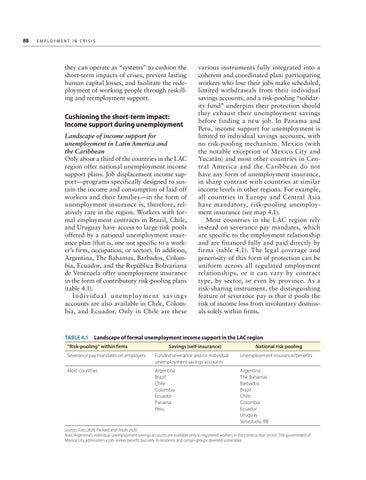88 E m p l o y m e n t
in Crisis
they can operate as “systems” to cushion the short-term impacts of crises, prevent lasting human capital losses, and facilitate the redeployment of working people through reskilling and reemployment support.
Cushioning the short-term impact: Income support during unemployment Landscape of income support for unemployment in Latin America and the Caribbean Only about a third of the countries in the LAC region offer national unemployment income support plans. Job displacement income support—programs specifically designed to sustain the income and consumption of laid-off workers and their families—in the form of unemployment insurance is, therefore, relatively rare in the region. Workers with formal employment contracts in Brazil, Chile, and Uruguay have access to large risk pools offered by a national unemployment insurance plan (that is, one not specific to a worker’s firm, occupation, or sector). In addition, Argentina, The Bahamas, Barbados, Colombia, Ecuador, and the República Bolivariana de Venezuela offer unemployment insurance in the form of contributory risk-pooling plans (table 4.1). I nd iv idu a l u nemploy ment s av i ng s accounts are also available in Chile, Colombia, and Ecuador. Only in Chile are these
various instruments fully integrated into a coherent and coordinated plan: participating workers who lose their jobs make scheduled, limited withdrawals from their individual savings accounts, and a risk-pooling “solidarity fund” underpins their protection should they exhaust their unemployment savings before finding a new job. In Panama and Peru, income support for unemployment is limited to individual savings accounts, with no risk-pooling mechanism. Mexico (with the notable exception of Mexico City and Yucatán) and most other countries in Central America and the Caribbean do not have any form of unemployment insurance, in sharp contrast with countries at similar income levels in other regions. For example, all countries in Europe and Central Asia have mandatory, risk-pooling unemployment insurance (see map 4.1). Most countries in the LAC region rely instead on severance pay mandates, which are specific to the employment relationship and are financed fully and paid directly by firms (table 4.1). The legal coverage and generosity of this form of protection can be uniform across all regulated employment relationships, or it can vary by contract type, by sector, or even by province. As a risk-sharing instrument, the distinguishing feature of severance pay is that it pools the risk of income loss from involuntary dismissals solely within firms.
TABLE 4.1 Landscape of formal unemployment income support in the LAC region “Risk-pooling” within firms
Savings (self-insurance)
National risk pooling
Severance pay mandates on employers
Funded severance and/or individual unemployment savings accounts
Unemployment insurance/benefits
Most countries
Argentina Brazil Chile Colombia Ecuador Panama Peru
Argentina The Bahamas Barbados Brazil Chile Colombia Ecuador Uruguay Venezuela, RB
Sources: Fietz 2020; Packard and Onishi 2020. Note: Argentina’s individual unemployment savings accounts are available only to registered workers in the construction sector. The government of Mexico City administers a job-seeker benefit, but only to residents and certain groups deemed vulnerable.

